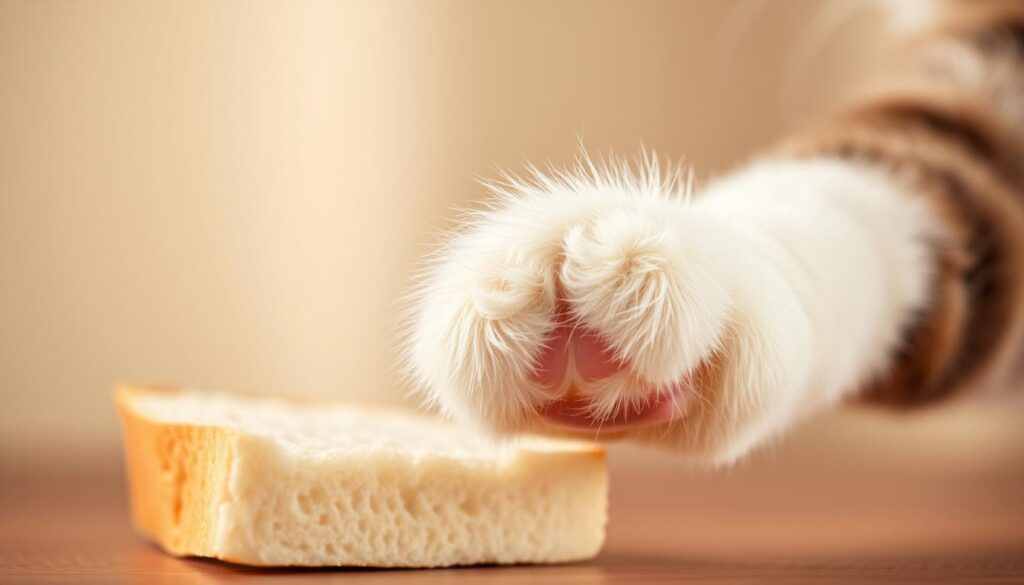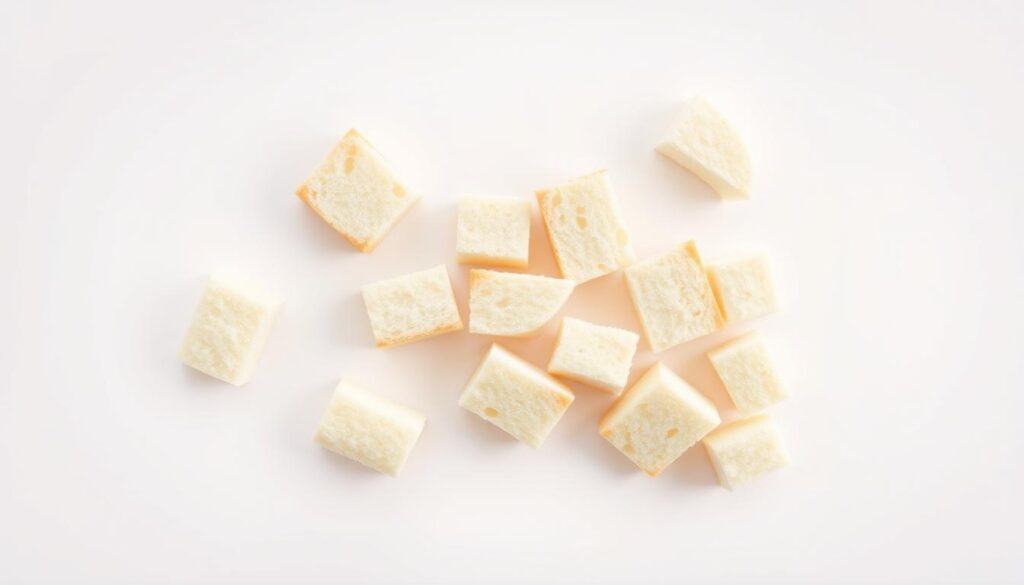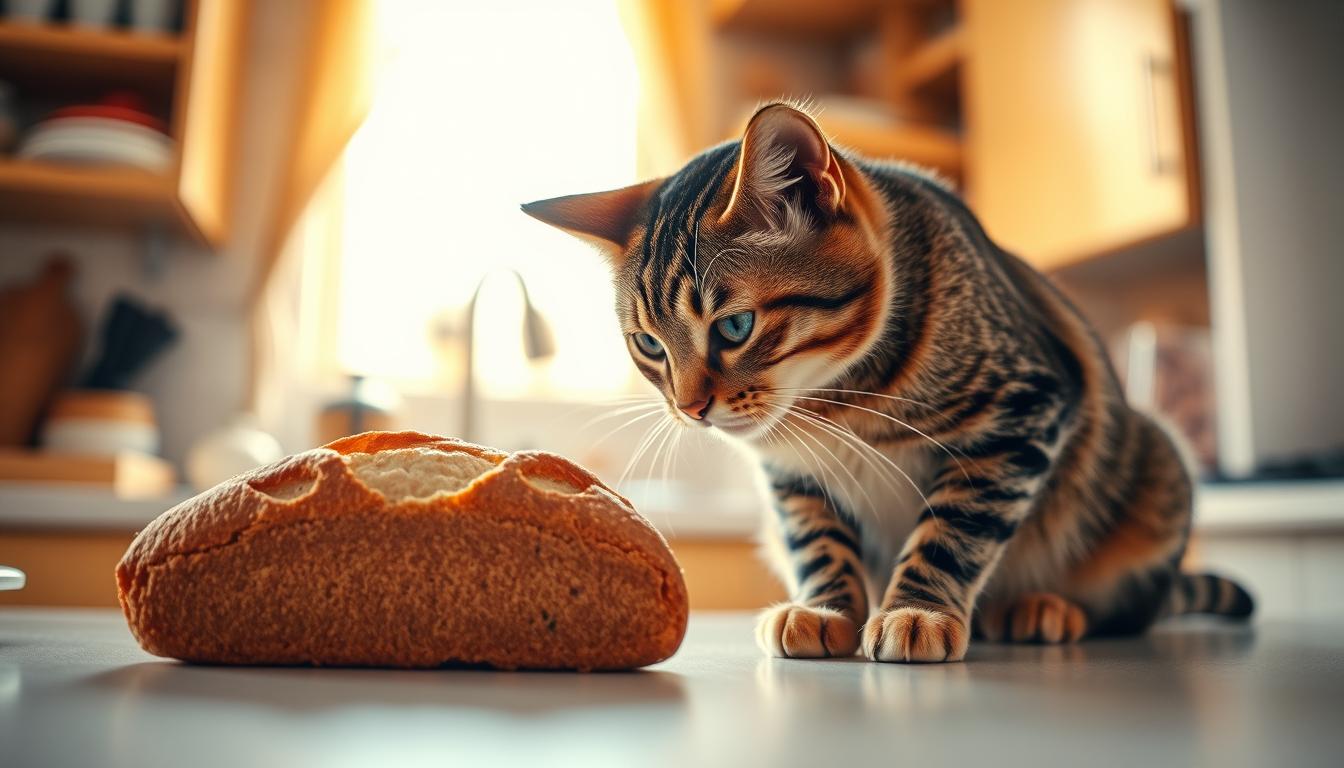Ever thought about giving your cat a tiny crumb from your sandwich? The question “can cats eat bread?” is often asked. But, the answer needs careful thought. A small piece of plain, baked bread is not toxic to cats. Yet, it’s crucial to know when and how to give it to them safely.
Cats need meat-based diets, not bread. A single slice of bread has 20% of a cat’s daily calories but lacks proteins. Raw dough is especially dangerous—it can cause severe bloating in their stomachs. This guide will help you understand the facts to keep your cat safe and happy.
Key Takeaways
- A tiny piece of plain baked bread is safe but should never replace their main meals.
- Raw dough or yeast-based products pose life-threatening risks due to fermentation.
- Breads with garlic, raisins, or chocolate are toxic and must be avoided.
- Cats need meat-based nutrients like taurine, which bread cannot provide.
- Always prioritize commercial cat treats or cooked meats over bread for their health.
Understanding Your Cat’s Nutritional Needs
Cats need a diet rich in protein, not carbs like bread. It’s important to balance their diet carefully. This is because their bodies are made to eat animal-based foods, not plant-based ones like bread.
“Cats are obligate carnivores, meaning their diet primarily consists of meat, with carbohydrates like bread providing little to no nutritional value.” – University of Missouri Small Animal Clinical Nutrition Service
The Carnivorous Nature of Cats
Your cat’s body is built for eating meat. They have short digestive tracts that can’t handle complex carbs well. Raw bread dough can cause bloating, and baked bread doesn’t give them any important nutrients. Here are some key points:
- Cats can’t break down plant carbs because they lack a certain liver enzyme
- They need 2-3 times more protein than omnivores
- They don’t need dietary fiber from plants
Essential Nutrients for Feline Health
Make sure your cat gets these important nutrients:
- Taurine: It’s crucial for their heart and eyes
- Arachidonic acid: It keeps their skin and coat healthy
- Vitamins A/D: They help their immune system
Bread doesn’t have these nutrients, making it a bad choice. But, commercial cat foods are made to give them what they need.
Why Humans and Cats Differ
Humans eat grains and veggies, but cats need:
- 2x more protein than dogs
- No carbs
- Special amino acids found only in animal products
Even a little bit of bread can take away from their regular food. Treats should only be 10% of their daily calories, about 25 calories for most cats.
Can Cats Eat Bread? The Simple Answer
Cats and bread aren’t a natural pair, but yes, cats can eat a little plain bread without harm. But, it’s not good for them. Cats need meat to stay healthy, not bread.
Small amounts of plain white or wheat bread won’t hurt your cat. But, it doesn’t give them any good nutrients. Cats can’t digest carbs well, so bread is not a good choice for them. Stay away from flavored breads like garlic or pumpkin bread because they can upset your cat’s stomach.
| Bread Type | Risks and Considerations |
|---|---|
| White Bread | High in carbs, offers no nutritional benefits. Use only as an occasional treat. |
| Wheat Bread | Safer if additive-free, but still lacks nutrients. Check for harmful ingredients like raisins or nuts. |
| Pumpkin Bread | Contains sugar, spices, and additives. Avoid due to potential toxicity from ingredients like cinnamon. |
| Hawaiian Bread | Sweeteners and fruit additives increase gastrointestinal risks. Not recommended. |
| Cornbread | High in calories but non-toxi. Offer sparingly and remove any corn kernels. |
Remember, cats should never eat bread instead of their regular meat meals. If your cat wants your food, give them vet-approved treats like cooked meat or catnip. Always check with your vet before giving them human food.
The Nutritional Profile of Bread
When thinking about bread in a cat’s diet, we should look at more than just safety. Cats eating bread get mostly empty calories. It’s not a good choice for their diet:
Carbohydrates and Your Cat’s Digestive System
Cats can’t digest bread’s starches well. Their bodies focus on protein and fat, making carbs hard to break down. This can cause bloating or stomach problems if they eat too much bread.
Caloric Content and Weight Management Concerns
A single slice of white bread has about 70 calories. That’s almost 10% of a 10-pound cat’s daily calorie needs. Eating too many treats like this can lead to obesity. Obesity increases the risk of diabetes and joint problems.
Bread’s Lack of Essential Feline Nutrients
Bread has very little protein, vitamins, or minerals cats need. Here’s how it compares to what cats really need:
- Protein: Cats need 22 amino acids, 11 must come from meat. Bread has 0.8g protein per slice, which is not enough.
- Vitamins/Minerals: Bread lacks vitamin A, B12, and taurine. These are important for vision and heart health.
- Fats: Bread has only a small amount of healthy fats. Cats naturally eat foods with 50% fat.
While a little plain bread is okay for most cats, it should not replace their high-protein diet. Choose nutrient-rich foods like poultry or fish to meet your cat’s needs.
Potential Risks of Feeding Bread to Your Cat
If you feed your cat bread, it is likely to be fine. However, too much bread can cause digestive upset, such as vomiting or diarrhoea. Monitor your cat and consult a vet if symptoms appear.

Cats can’t digest carbs well, making bread a risky treat. While it’s okay in small amounts, regular bread can upset their natural diet. Here’s what to watch for:
Digestive Issues and Gastrointestinal Discomfort
Bread’s high carb content can strain a cat’s digestive system. Overeating may cause:
- Vomiting or diarrhea
- Bloating or constipation
- Abdominal pain
Raw dough is especially dangerous: yeast ferments in the stomach, producing alcohol and expanding gas. This can cause severe bloating or ethanol poisoning.
Obesity and Weight-Related Health Problems
Bread offers no protein but gives 20% of a cat’s daily calories in one slice. This can lead to weight gain. Obese cats face higher risks of diabetes, arthritis, and heart disease. Always consider the caloric cost against nutritional value.
Allergic Reactions to Wheat and Gluten
Some cats develop allergies to wheat or gluten, causing skin rashes, itching, or breathing trouble. Watch for swelling around the face or lethargy. Even plain bread offers no nutrients—opt for meat-based treats instead.
Different Types of Bread and Their Safety for Cats
Cats and bread can be a tricky mix. Can cats eat bread safely? It really depends on the type. Plain, fully baked bread is usually okay, but flavored breads can be risky.
| Bread Type | Safety Rating | Risks/Notes |
|---|---|---|
| Plain White Bread | Low Risk | Contains carbs but no direct toxins. Offer tiny amounts only. |
| Sourdough | Moderate Risk | Higher acidity may upset stomachs. Avoid wild yeast fermentation risks. |
| Whole Wheat | Moderate Risk | Fiber content may cause digestive upset. No nutritional benefit. |
| Rye Bread | Moderate Risk | May cause bloating. Avoid if your cat has sensitive digestion. |
| Artisan/Flavored Breads | High Risk | Rarely safe. Garlic, raisins, or nuts can be lethal. |
Never give raw dough to cats. It can cause alcohol and gas in their stomachs, leading to serious bloat. Even a little sweet bread can upset their stomachs.
- Avoid bread with cheese or butter—dairy often causes digestive issues
- Check for toxic additives like chocolate chips or xylitol
- Stick to 10% treat rule: bread should never exceed 10% of daily calories
Commercial cat treats are better than bread for their nutrition. Always talk to your vet before introducing new foods to cats with diabetes or special diets.
Dangerous Bread Ingredients That Threaten Your Cat’s Health
Whether is bread harmful for cats depends on what’s in it. Some breads have ingredients that are very bad for cats. Even a little bit can hurt your pet. Always read the labels before giving bread to your cat.
Garlic and Onion Toxicity
Breads like garlic bread or focaccia have onions or garlic. These can harm your cat’s red blood cells, leading to anemia. Signs include weakness and pale gums. Even a small amount can be very dangerous.
Raisins and Other Harmful Add-ins
- Raisins, currants, or chocolate in sweet breads can cause kidney failure or poisoning.
- Nuts or artificial flavors may also cause vomiting or diarrhea.
Xylitol and Artificial Sweeteners
Xylitol in “sugar-free” breads can cause a big drop in blood sugar. Signs like lethargy or collapse need quick vet care. Always avoid products with xylitol.
If your cat eats bread with these ingredients, it can be very dangerous. Call the Pet Poison Helpline at 1-800-222-1222. Always get vet advice before trying to help your cat at home.
Signs Your Cat May Have Eaten Too Much Bread
If your cat eats too much bread, they might show some signs. Cats can get upset stomachs from eating too much bread. Look out for these symptoms:
- Vomiting or retching attempts
- Diarrhea or loose stools
- Lethargy or reduced activity
- Loss of appetite for regular meals
- Abdominal swelling or sensitivity
Bread has a lot of carbs, which can upset a cat’s stomach. If your cat eats raw bread dough, the yeast can make gas and alcohol in their belly. This can cause bloating, pain, and even alcohol poisoning, which is a serious emergency.
Even baked bread can make your cat uncomfortable. If they keep vomiting or won’t eat after eating bread, it’s a sign they don’t like it.
Watch for signs like belly grooming or whining when touched. Sudden weight loss or constipation can also mean their stomach is upset. If these problems last more than 12 hours, call your vet. It’s best to stick to a meat-based diet for your cat to avoid health problems.
How to Safely Introduce Small Amounts of Bread to Your Cat
If you want to give your cat bread as a treat, make sure it’s safe. Only use bread without harmful ingredients like raisins, garlic, or xylitol. Can cats eat bread but only in very small amounts.

Proper Portion Sizes for Occasional Treats
Begin with a tiny piece, about the size of a pea. For a 10-lb cat, this is 2–5 calories. Treats should not make up more than 10% of their daily calories (20 calories for a 10-lb cat). Always give bread plain and at room temperature.
- Never offer more than ½ tsp per serving
- Choose unseasoned, additive-free bread
- Check labels for toxic ingredients like chocolate or onions
| Cat’s Weight | Max Portion | Frequency |
|---|---|---|
| 8-10 lbs | ½ tsp | Rarely (1x/week) |
| 11-15 lbs | ¾ tsp | Monthly |
Monitoring Your Cat After Trying New Foods
Keep an eye on your cat for 24 hours after trying new foods. Look out for signs of trouble like:
- Vomiting or diarrhea
- Bloating or stomach pain
- Lethargy or loss of appetite
If you see these signs, stop giving bread right away. If worries persist, talk to your vet.
Healthier Alternatives to Bread for Cat Treats
Choosing treats that match a cat’s natural diet is key. Bread has no nutritional value, so it’s better to choose other options. These should support a balanced bread and cat diet. Make sure these treats are under 10% of their daily food.
“A cat’s diet should be 90% nutritionally complete meals, with treats making up only 10% for safety and health.” – American Association of Feline Practitioners
Commercial Treats Tailored to Feline Needs
Look for treats made just for cats. Here are some good choices:
- Freeze-dried meat or fish
- Dental treats to support oral health
- Options with added taurine and vitamins
Make sure the first ingredient is real meat. Avoid wheat or soy. Brands like Wellness and Blue Buffalo have treats that meet AAFCO standards.
Safe Human Foods for Occasional Treats
Cats can have small amounts of certain human foods. Here are some safe options:
- Plain cooked chicken or turkey (no seasoning)
- Boiled egg whites in tiny portions
- Cooked white fish (like cod or haddock)
Always give these foods plain and in small amounts. Don’t give fatty cuts or bones.
When to Consult Your Veterinarian About Your Cat’s Diet
If your cat eats bread with raisins, garlic, or chives, call a vet right away. These can lead to bread in cat’s diet risks like vomiting or kidney damage. Even a little bit of these toxic ingredients needs quick attention.
- Watch for symptoms like vomiting, lethargy, or diarrhea after your cat eats bread.
- Seek help if your cat accidentally eats raw dough, which can ferment in their stomach, causing alcohol poisoning.
- Consult a vet if your cat has a history of diabetes or obesity, as bread’s carbs may worsen these conditions.
| Symptom | Action |
|---|---|
| Severe vomiting/diarrhea | Call a vet immediately |
| Lethargy or weakness | Monitor and consult within 24 hours |
| Loss of appetite for >12 hours | Seek advice on feline nutrition and bread adjustments |
Always tell your vet if your cat eats bread, even if they seem okay. Kittens, seniors, or cats with allergies need extra care. Regular vet visits help make sure their diet is right for their health.
For emergencies, call the Pet Poison Helpline or ASPCA Animal Poison Control. Tell them what your cat ate and when.
Conclusion: Balancing Treats and Proper Nutrition for Your Feline Friend
Remember, while plain bread isn’t toxic to cats, it doesn’t provide any nutritional value. Cats need animal-based proteins, not bread. Over 70% of owners might not know that common foods like bread lack the nutrients cats need. It’s important to focus on their well-being with species-appropriate meals.
Cats are obligate carnivores, needing a diet rich in meat proteins. Treats like bread should never replace their main nutrition. High-quality cat food ensures they get the amino acids and nutrients they need. Look for ingredients like poultry or fish proteins in their food.
Before adding new foods, talk to your vet. They can suggest safe alternatives to bread, like protein-rich snacks. Even small treats can affect a cat’s weight, so watch the portions. Cats can’t digest carbs well, making grains like bread useless.
Sharing meals with pets might seem caring, but choose foods that fit their biology. Eggs, in moderation, can provide protein but shouldn’t be a main meal. Watermelon can hydrate kittens, but only in tiny amounts and without seeds. Always prioritize vet-approved nutrition.
Responsible feeding means picking options that meet their dietary needs. By focusing on their nutritional needs, you keep them healthy and allow safe treats now and then. Your vet is the best source for advice on bread in cat’s diet and other food choices.
FAQ
Can cats eat bread?
Is bread harmful for cats?
What should I consider before sharing bread with my cat?
Could my cat have a negative reaction to bread?
Are certain types of bread safer for cats?
What ingredients in bread should I avoid giving my cat?
How can I tell if my cat has eaten too much bread?
What portion size of bread is appropriate for my cat?
What alternatives to bread are better for cats?
When should I consult my veterinarian about my cat’s diet?
Source Links
- Can Cats Eat Bread | Expert Advice on Feeding Cats – https://felinefancy.co.uk/blogs/cat-care-tips/can-cats-eat-bread?srsltid=AfmBOoraZPOjfU3zFDhgGNzI0jN1Ol60eLlYNiGeoArrszkqzs9WdRij
- Can Cats Eat Bread? A Safe Guide for Cat Owners – https://petfirst.ae/can-cats-eat-bread/
- Why Does My Cat Like Bread So Much? Risks & Benefits | PangoVet – https://pangovet.com/pet-behavior/cats/why-does-my-cat-like-bread-so-much/
- 9 Human Foods That Are Safe for Your Kitty to Snack On – https://www.dailypaws.com/cats-kittens/cat-nutrition/what-can-cats-eat/human-foods-for-cats
- Should You Give Your Cat Bread? | Read Before You Feed – https://onpetscare.com/blog/should-you-give-your-cat-bread/
- Can Cats Eat Bread? What Every Cat Owner Should Know – https://thepetfantasy.com/can-cats-eat-bread/
- Human Foods That Are Poisonous to Cats – https://www.thesprucepets.com/human-food-and-cats-551947
- Can Cats Eat This? – The Ultimate Cat Snack Guide – Petchef – Healthy pet food – https://petchef.my/can-cats-eat-ultimate-cat-snack-guide/
- Can Cats Eat Bread? Find Out Here! – https://www.thesprucepets.com/can-cats-eat-bread-8724767
- Can Cats Eat Bread? Vet-Approved Facts & FAQ – Catster – https://www.catster.com/nutrition/can-cats-eat-bread/
- Can Cats Eat Bread? Understanding Cat Diet – https://noblevetclinic.com/blog/can-cats-eat-bread-understanding-cat-diet
- Can Cats Eat Bread | Expert Advice on Feeding Cats – https://felinefancy.co.uk/blogs/cat-care-tips/can-cats-eat-bread?srsltid=AfmBOooklHWONJ1M22wGN-zOEoXc-5H28UhUvWaHWw02v1ucGG4vQYIS
- Can My Cat Eat That? The Most Commonly Asked Culprits Answered by a Veterinarian – https://www.hamptonveterinaryhospital.com/services/blog/can-my-cat-eat-most-commonly-asked-culprits-answered-veterinarian
- Can Cats Eat Bread | Expert Advice on Feeding Cats – https://felinefancy.co.uk/blogs/cat-care-tips/can-cats-eat-bread?srsltid=AfmBOoqjSqz9x3lKRzIkUDqF0VAhno9HdNzLlXHUXCFKDPx_0ddOj1mS
- Can Cats Eat Bread | Expert Advice on Feeding Cats – https://felinefancy.co.uk/blogs/cat-care-tips/can-cats-eat-bread?srsltid=AfmBOooyWl1QtJ3T2ObQ__UDm0VrW0DcUm6sNXdT_tdrelAmyZ2bbygO
- Can cats eat bread? What to know before you feed this snack – https://www.pawtracks.com/cats/can-cats-eat-bread/
- Can Cats Eat Bread? – Is Bread Toxic to Cats? – Bella+Duke – https://www.bellaandduke.com/cats/expert-advice-cats/cat-nutrition/can-cats-eat-bread/
- Can Cats Eat Bread? Safety, Benefits, and Risks Explained – https://drpashu.com/can-cats-eat-bread/
- Can Cats Eat Bread? The Benefits Of Bread For Cats | Sheba® Singapore – https://www.sheba.com.sg/cat-language-of-love/feeding-articles/can-cats-eat-bread-everything-you-need-to-know-about-bread-and-cats
- Can Cats Have Bread? Vet-Reviewed Types, Toppings, & FAQ | PangoVet – https://pangovet.com/pet-nutrition/cats/can-cats-eat-bread/
- What Human Foods Can Cats Eat? – https://www.thehonestkitchen.com/blogs/pet-wellness/human-foods-cats-can-eat?srsltid=AfmBOoptrZZ8J0c4Mz1Jk79jhRrqZo2mfLkIAcl2eV1IXIipOyOMM1HT
- Can Cats Eat Bread | Expert Advice on Feeding Cats – https://felinefancy.co.uk/blogs/cat-care-tips/can-cats-eat-bread?srsltid=AfmBOoqr2y_tDWyp25YuZK7WLvYbD4EMnskanUpzCfU0Z-FOjP-NjiND
- What Human Foods Can Cats Eat? – https://www.thehonestkitchen.com/blogs/pet-wellness/human-foods-cats-can-eat?srsltid=AfmBOoo-Tq5ppnYLrbSDckGhq9zu6y7-p-CxM35eoZOGq5u32o4lFm4o
- Can Cats Eat Bread? What You Need to Know About Feeding Bread to Your Cat – https://www.yahoo.com/lifestyle/cats-eat-bread-know-feeding-150000957.html
- What Can’t Cats Eat? 8 Toxic Foods for Cats – https://www.petmd.com/cat/nutrition/toxic-foods-for-cats
- Can Cats Eat Bread | Expert Advice on Feeding Cats – https://felinefancy.co.uk/blogs/cat-care-tips/can-cats-eat-bread
- Can Cats Eat Banana Bread? Vet-Approved Facts & FAQ – Catster – https://www.catster.com/nutrition/can-cats-eat-banana-bread/
- What Can Cats Eat Besides Cat Food? Vet-Verified Nutrition Guide – Catster – https://www.catster.com/nutrition/what-can-cats-eat-besides-cat-food/
- Can Cats Eat Eggs? – Cats Care – https://ultimatecatguide.com/can-cats-eat-eggs/
- Can kittens eat watermelon? Our vet answers – https://www.yahoo.com/lifestyle/kittens-eat-watermelon-vet-answers-120000186.html
